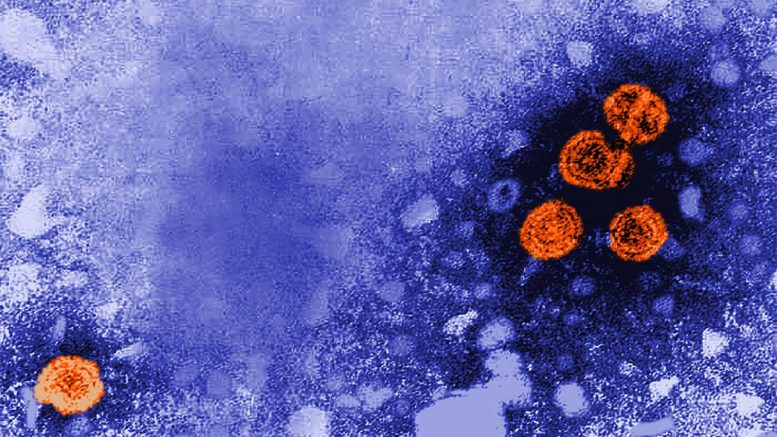This transmission electron microscopic (TEM) image revealed the presence of hepatitis B virus (HBV) particles (orange). The round virions, which measure 42nm in diameter, are known as Dane particles. Courtesy of the CDC
A highly effective vaccine to prevent hepatitis B virus (HBV) infection has been available for nearly 40 years, yet millions of people worldwide continue to become infected with the liver-attacking virus and more than 600,000 die from its complications each year, according to the Centers for Disease Control and Prevention (CDC). A new strategic plan from the National Institutes of Health outlines efforts to intensify ongoing HBV research with the goals of developing a cure and improving scientific understanding of the virus while creating improved strategies for screening and treating patients.
HBV is transmitted through sex, contact with infected blood or bodily fluids, or from an infected mother to her baby, and can result in either an acute infection that resolves or a chronic infection. Chronic HBV infection can lead to serious health issues including cirrhosis (scarring of the liver), liver failure or liver cancer. Approximately 80% to 90% of infants infected during the first year of life will develop chronic infection, while only 5% of people infected as adults will become chronically infected. Between 850,000 and 2 million people in the United States have chronic hepatitis B; globally, that number is 257 million, according to the World Health Organization.
Although treatments are available to control HBV infection, they must be taken for years if not for life. Additionally, high medication costs, the need for continuous disease monitoring and adhering to treatment regimens present significant burdens for people with chronic hepatitis B. Even among those treated for chronic hepatitis B, the risk of developing cirrhosis and liver cancer remains elevated.
Scientific discoveries within the past decade suggest that a hepatitis B cure is possible. The new NIH plan defines a hepatitis B “cure” as a sustained loss of a specific protein on the surface of HBV called hepatitis B virus surface antigen — preferably with antibodies against the antigen and undetectable viral DNA after completion of a finite course of treatment. Ideally, a hepatitis B cure would also reduce a person’s risk of liver failure and liver cancer. To effectively address the global public health challenge posed by HBV, a curative treatment will need to complement better approaches to screening, follow-up care, and vaccination coverage.
The Strategic Plan for Trans-NIH Research to Cure Hepatitis B focuses on three key research areas. The first priority calls for a better understanding of hepatitis B biology, including the viral and host factors that lead to disease, immunity, reactivation and transmission, as well as the impact of co-infections with other hepatitis viruses and HIV. An improved understanding of these factors and the HBV lifecycle is essential to developing a cure.
The second priority emphasizes the development and sharing of tools and resources to support fundamental research and product development. This includes standardizing and sharing reagents and assays; improving and creating new animal models to study the progression of human liver disease and mother-to-child transmission; and establishing biomarkers for disease progression and response to therapy.
The third priority calls for the creation of strategies to cure and prevent hepatitis B infection. A cure could include approaches to blocking viral replication, stimulating the anti-HBV immune responses or eliminating HBV-infected cells. However, achieving a cure requires strengthening existing public health efforts for promoting hepatitis screening, ensuring that high-risk and underserved populations have access to vaccination, and prioritizing follow-up to care and adherence to treatment, according to the plan.
The strategic plan builds on NIH’s ongoing hepatitis B research portfolio and the U.S. National Viral Hepatitis Action Plan. NIH sought input from academia, patient advocacy organizations, private and nonprofit companies, government organizations, and clinical trial networks funded by the NIH in the development of this strategic plan.
Source: National Institutes of Health (NIH)

Be the first to comment on "NIH Strategic Plan Details Pathway to Achieving Hepatitis B Cure"